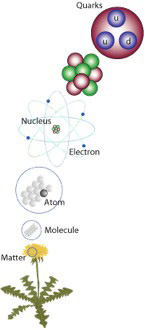Matter versus antimatter
Matter is built from a handful of subatomic particles
When we look at the world around us, we see what appears to be almost limitless variation. At a fundamental level, however, we know that everything is made up of just one thing: atoms.
Although tiny – a human hair, for example, is about a million atoms wide – atoms are themselves made up of a compact nucleus of protons and neutrons, around which electrons whirl. Like a sub-atomic set of Russian dolls, protons and neutrons are, in turn, built out of yet smaller pieces called ‘quarks’.
From here on it’s impossible to get any smaller. As far as scientists can tell, both quarks and electrons seem to be truly fundamental particles – indivisible, basic pieces of matter from which everything is built.
Antimatter: a mirror image of matter
Matter might dominate the Universe today, but this hasn’t always been the case. When particles of matter were forged in the intense heat of the Big Bang, they were accompanied by equal quantities of ‘anti-particles’, identical in mass but with an opposite electric charge.
Although antimatter doesn’t seem to be very common in the Universe today, it is frequently created at laboratories like CERN, where particle accelerators simulate the high-energy conditions that existed at the beginning of the Universe.
From these experiments, we’re sure that every time energy is transformed into a quark or an electron, an anti-quark or anti-electron (called a positron) is also produced, and many hundreds of different antiparticles are now known. At CERN, things have even gone a step further with the creation of the first ever anti-atom – anti-hydrogen – in 1995.
In theory, there is no reason why antiparticles couldn’t combine to build larger and larger objects – anti-molecules, anti-life, even whole anti-galaxies.
Where has all the antimatter gone?
When antimatter and matter come into contact, the result is dramatic. In the blink of an eye they both vanish, destroying one another and leaving behind a flash of energy.
This explosive relationship raises some intriguing questions. For example, if matter and antimatter were created in equal quantities during the Big Bang, why do we find ourselves living in a Universe made only of matter? Could some unknown mechanism have stepped in to prevent matter and antimatter completely annihilating each other? Or perhaps vast clusters of antimatter still exist in some far-flung corner of the Universe?
Such questions have led to numerous speculative theories, but most scientists believe the imbalance we see today between matter and antimatter reflects a subtle difference between the two. For instance, a slight variation in the rate at which matter and antimatter decay can help explain why a small, but highly significant, fraction of the matter has survived to build us and the Universe we inhabit.
It is precisely these slight asymmetries between matter and antimatter that LHCb has been set up to study.

